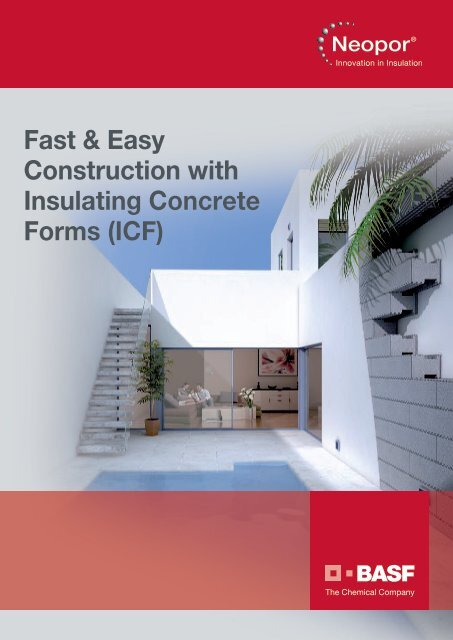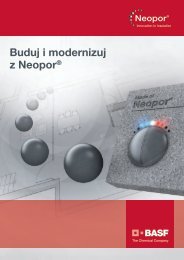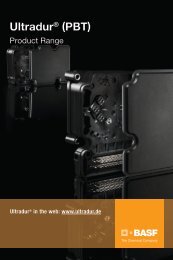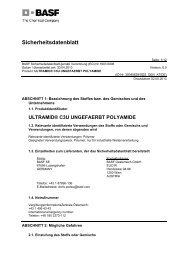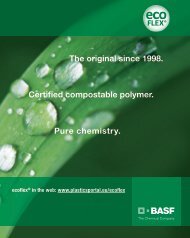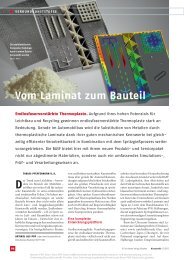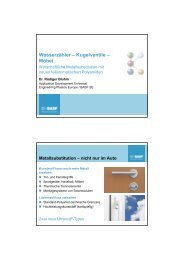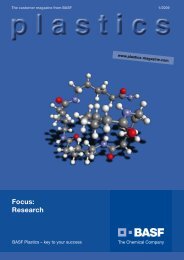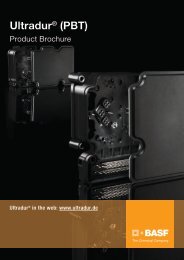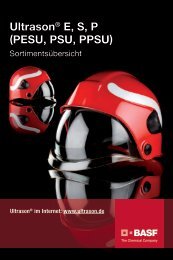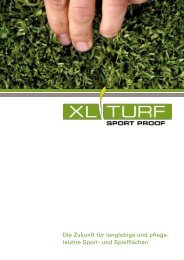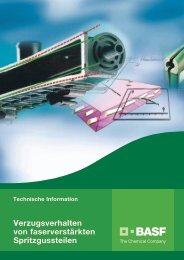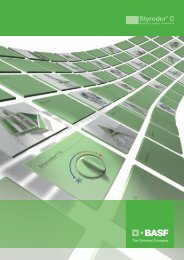Neopor (EPS) - Application brochure - BASF Plastics Portal
Neopor (EPS) - Application brochure - BASF Plastics Portal
Neopor (EPS) - Application brochure - BASF Plastics Portal
Create successful ePaper yourself
Turn your PDF publications into a flip-book with our unique Google optimized e-Paper software.
Fast & Easy<br />
Construction with<br />
Insulating Concrete<br />
Forms (ICF)
Quality Products from <strong>BASF</strong>—The Benchmark<br />
in Polystyrene For Over 50 years<br />
Styropor ® —Behind this name lies a success story<br />
that is everyone´s goal. <strong>BASF</strong> discovered<br />
a classic over 50 years ago in expandable<br />
polystyrene (<strong>EPS</strong>). Under the tradename<br />
Styropor, <strong>EPS</strong> is now the solution for efficient<br />
insulation and safe packaging worldwide.<br />
With <strong>Neopor</strong> ® , <strong>BASF</strong> has taken the classic<br />
Styropor a step further. This new material for<br />
modern insulating materials is foamed just like<br />
Styropor and processed to boards and molded<br />
parts.<br />
The vital difference can be seen with the naked<br />
eye in the silver-gray color. In <strong>Neopor</strong>, graphite<br />
is added to the material, absorbing and reflecting<br />
heat radiation and improving the insulating<br />
performance of <strong>EPS</strong> by up to 20 percent.<br />
Products made from <strong>BASF</strong>´s <strong>Neopor</strong> are an<br />
economic investment in the future and add to<br />
the value of a property.<br />
1930 1995 <strong>Neopor</strong> ®<br />
Patent for the polymerization of<br />
monostyrene<br />
Patent for <strong>Neopor</strong> ®<br />
1920<br />
1925 1930 1940 1950 1960 1970 1980 1990 2000 2005<br />
1951<br />
Styropor ®<br />
Patent for expandable<br />
polystyrene (<strong>EPS</strong>, Styropor ® )
Small, Round, Black—<br />
One Material,<br />
Many <strong>Application</strong>s<br />
<strong>Neopor</strong> ® —<strong>Neopor</strong> is composed of small<br />
black beads of polystyrene (<strong>EPS</strong>) containing<br />
blowing agent, which makes it expandable.<br />
<strong>BASF</strong> produces this unique material, which<br />
is processed by foam manufacturers into<br />
insulating materials for a wide range of<br />
different applications.<br />
40<br />
at least<br />
saves cooling energy<br />
These black beads are foamed by converters on<br />
conventional <strong>EPS</strong> machines and processed to<br />
silver-gray foam blocks and molded parts with<br />
up to 20 percent better insulating performance<br />
than conventional <strong>EPS</strong>. The blocks are then cut<br />
to boards of different thicknesses.<br />
<strong>Neopor</strong> insulating materials offer greater<br />
insulating performance and up to 50 percent<br />
lower use of materials than conventional<br />
<strong>EPS</strong>, helping environmental conservation and<br />
saving money. Environmentally-friendly <strong>Neopor</strong><br />
insulating materials do not contain CFCs,<br />
HCFCs, HFCs, or other halogenated cell<br />
gases. They contain air as cell gas, which<br />
guarantees the preservation of the thermal<br />
conductivity throughout the life of the<br />
construction.<br />
<strong>Neopor</strong> insulating materials therefore represent<br />
a modern, environmentally aware lifestyle.<br />
We call it: "Innovation in Insulation."
<strong>Neopor</strong> ® —The Simple Way of Building and<br />
Insulating With Insulating Concrete Forms (ICF)<br />
Insulating concrete forms made of <strong>Neopor</strong> ® can be<br />
produced with special molding forms. They are used<br />
as wall and ceiling elements. Thanks to the special<br />
connection system, the elements are easily assembled<br />
on the construction site and can then, with or without<br />
reinforcement, be filled with concrete. The finished<br />
interior and exterior walls are monolithically molded<br />
concrete walls with very good insulating properties.<br />
This construction system is cost-efficient, fast, and<br />
earthquake-safer.<br />
Insulating concrete forms made of <strong>Neopor</strong> have also<br />
proven to be extremely suitable in the construction<br />
of low-energy and passive houses. With <strong>Neopor</strong>, it<br />
is possible to achieve significantly higher insulating<br />
properties than with conventional <strong>EPS</strong> for those<br />
building components where the heat insulating<br />
properties are of special importance.<br />
Exterior plaster<br />
Reinforcement<br />
Insulating concrete forms<br />
(outside) made of <strong>Neopor</strong> ®<br />
Concrete core<br />
Insulating concrete forms<br />
(inside) made of <strong>Neopor</strong> ®<br />
Lining on the inside<br />
Wall construction with insulating concrete forms<br />
made of <strong>Neopor</strong> ®
Insulating Concrete Forms Made of <strong>Neopor</strong> ®<br />
The Main Advantages at a Glance<br />
Fast assembly—The light weight of the form elements<br />
made of <strong>Neopor</strong> ® expandable polystyrene beads<br />
(<strong>EPS</strong>) and the simple processing method ensure<br />
a quick and economic construction progress. The<br />
assembly of the elements is simple and possible<br />
without any special construction training and heavy<br />
construction equipment. A team of 3-4 experienced<br />
workers is able to set up the walls of a average<br />
single-family house within a single day.<br />
Rational logistics—The weight per m² of masonry of<br />
form elements made of <strong>Neopor</strong> only amounts to a<br />
fraction of that of stones or concrete. This considerably<br />
facilitates the logistics on the construction site and<br />
speeds up the construction process.<br />
Simple processing method—Form elements can<br />
easily be cut to size with a usual handsaw, a knife,<br />
or a hot-wire cutter. Holes or slots for electrical and<br />
sanitary installations can be formed in a time- and<br />
cost-saving manner.<br />
Flexible wall cladding—After filling up with concrete,<br />
the walls can be plastered without any additional<br />
substrate preparation. Virtually any kind of covering<br />
material can also be used for the cladding of interior<br />
walls. For instance, tiles can be glued directly onto<br />
the form elements.<br />
Efficient building and insulation—With the comparably<br />
thin insulating concrete forms made of <strong>Neopor</strong>, it is<br />
possible to achieve an equally efficient acoustic and<br />
thermal insulation as with the significantly thicker<br />
"classical" walling materials. This provides for<br />
valuable extra living space without changing the<br />
exterior dimensions of the building.<br />
Durable and solid—Due to the massive concrete<br />
core, the houses constructed with insulating concrete<br />
forms have the same durability and stability as<br />
conventional buildings. Furthermore, the insulating layer<br />
of <strong>Neopor</strong> protects the load-bearing concrete against<br />
adverse weather conditions. In Europe and the U.S.,<br />
insulating concrete forms have safely proven their<br />
efficacy over decades.<br />
Highly resistant and safe—Robust concrete, an<br />
energy-saving insulation and the cost-effective<br />
building method make insulating concrete forms made<br />
of <strong>Neopor</strong> the ideal protection against earthquakes,<br />
storms, or floods in disaster-prone regions.<br />
Easy unloading and transport thanks to its light weight<br />
Easy handling<br />
Photo: Izodom<br />
Photo: Izodom<br />
Photo: Izodom<br />
Wall filled up with silo technology or concrete skips
Insulating Concrete Forms Made of <strong>Neopor</strong> ® —<br />
Invest in a Global and Cost-effective Building<br />
System with Added Performance<br />
For the production of insulating concrete forms (ICF)<br />
made of <strong>Neopor</strong> ® , the <strong>Neopor</strong> beads supplied by <strong>BASF</strong><br />
are foamed in prefoaming machines and then pressed<br />
into various shapes in so-called "baking molds." The<br />
finished insulating concrete forms (ICF) are then directly<br />
delivered to the construction site, where, thanks to their<br />
low weight, the unloading and transporting on site can<br />
be done without the use of cranes or heavy machinery.<br />
Especially in the case of large-scale construction<br />
projects, such as residential estates or business<br />
centers with numerous buildings, the production<br />
facilities for <strong>Neopor</strong> insulating concrete forms (ICF)<br />
can also be installed in close vicinity of the construction<br />
site. Due to on-site production, it is possible to reduce<br />
time-consuming and costly material transports and<br />
construction times. This allows for an increased<br />
cost-effectiveness of construction projects.<br />
Ready-cast form element made of <strong>Neopor</strong> ®<br />
Photo: ® isorast GmbH<br />
<strong>Neopor</strong> ® beads<br />
supplied by <strong>BASF</strong><br />
Production of insulating<br />
concrete forms (ICF)<br />
made of <strong>Neopor</strong> ®<br />
Construction project with<br />
insulating concrete forms<br />
(ICF) made of <strong>Neopor</strong> ®
Large-scale construction<br />
project of a housing<br />
complex in the typical<br />
local architectural style with<br />
insulating concrete forms<br />
made of <strong>Neopor</strong> ®<br />
Photos: <strong>BASF</strong> SE<br />
7
<strong>Neopor</strong> ® —Keeping cool<br />
In regions with a rather cool climate, such as Central<br />
Europe, buildings have been successfully insulated<br />
against cold for decades. But thermal insulation<br />
is also of increasing importance in hot climates,<br />
such as in GCC countries. Here, however, insulating<br />
materials are mainly used for the cooling of buildings<br />
50 °C<br />
to counteract penetrating heat. Considering the<br />
increasing worldwide shortage of energy and raw<br />
materials, this allows for a cut of the tremendous<br />
cooling energy costs incurred by air-conditioning<br />
systems as well as of investments for the power<br />
plants necessary for their operation. In Dubai<br />
City, for instance, the use of efficient insulating<br />
materials for new buildings is in the meantime<br />
required by law.<br />
Thermal Insulation Against Heat<br />
for a Pleasant Indoor Climate with <strong>Neopor</strong> ®<br />
The purpose of thermal insulation in hot climates is to Massive and highly insulated wall constructions generally<br />
respond rather slowly to temperature changes<br />
reduce the heat input resulting from direct exposure to<br />
solar radiation in order to keep the interior pleasantly and keep the room temperature at a constant level.<br />
cool. The outside temperature constantly rises from This provides for a pleasant indoor climate.<br />
the early morning hours until the afternoon, the room<br />
temperature reaching the external temperature after How much heat arrives into the interior also depends<br />
a certain delay. The longer the heat flux through the on the efficiency of the insulation material used. With<br />
outer envelope into the interior of the building takes, its low thermal conductivity, the high-performance<br />
the better the rooms are protected against undesirable insulating material <strong>Neopor</strong> ® limits the penetration of<br />
overheating.<br />
heat from the warm to the cold side of a building in a<br />
particularly efficient way—from the inside outward at<br />
low temperatures and from the outside inward at high<br />
temperatures.<br />
Heat transfer through walls in hot climates<br />
Exterior Interior<br />
Exterior Interior<br />
Exterior plaster<br />
Exterior plaster<br />
Mansonry<br />
ICF (outside)<br />
Lining on the inside<br />
made of <strong>Neopor</strong> ®<br />
Concrete core<br />
ICF (inside)<br />
High heat transmission<br />
made of <strong>Neopor</strong> ®<br />
Lining on the inside<br />
Low heat transmission<br />
Uninsulated wall Insulated wall with ICF made of <strong>Neopor</strong> ®
Reduction of Cooling Energy Consumption<br />
Insulating Concrete Forms (ICF) Made of <strong>Neopor</strong> ®<br />
Infrared absorbers and reflectors contained in <strong>Neopor</strong> ®<br />
reduce heat dissipation and allow for an improvement<br />
of the insulating performance by 20% in comparison<br />
to standard <strong>EPS</strong>. Calculations carried out by the<br />
renowned Passivhaus Institut Darmstadt in Germany<br />
have shown that in hot climates, a building envelope<br />
insulated with <strong>Neopor</strong> both decreases the excess<br />
heating frequency and the hours of active cooling<br />
required. Depending on the respective house and<br />
construction type, this results in a reduction of<br />
energy consumption for cooling by at least 40%<br />
and a decrease in CO 2<br />
emissions.<br />
In this regard, the tried and tested insulating concrete<br />
forms (ICF) made of <strong>Neopor</strong>, which are filled with<br />
concrete after simple and fast assembly, are<br />
particularly cost-effective and efficient.<br />
Interior<br />
Exterior<br />
Through the combination of massive concrete and an<br />
inner and outer insulation layer, ICF is ideally suited in<br />
wall construction in climatically hot regions.<br />
Isotherm profile of an external wall<br />
with insulating concrete forms (ICF),<br />
base plate foundation, and flat roof<br />
Energy Requirement for Sensible Cooling<br />
Insulation thickness 20 cm<br />
Insulated building<br />
Insulation thickness 0 cm<br />
Uninsulated building<br />
Source: Passivhaus Institut Darmstadt, Germany<br />
0 20 40 60 80 100 120 140 160 180<br />
[kWh/m²a]<br />
Useful cold requirement as a function of insulation standard for all opaque building elements with Dubai as an example.
International Reference Cases—Individual,<br />
Stylish, and Energy-efficient<br />
The construction of buildings with insulating concrete<br />
forms has long been more than a vision of the future. The<br />
combination of massive concrete, a high-performance<br />
insulation layer consisting of <strong>Neopor</strong> ® on both sides,<br />
and the fast and simple building method are convincing<br />
arguments for builders, planners, developers, and<br />
large-scale investors all over the world.<br />
The sample buildings shown here represent only a small<br />
selection of the most successful reference cases where<br />
insulating concrete forms made of <strong>Neopor</strong> were used<br />
and unmistakably prove the successful application of<br />
this energy-efficient and cost-effective building system.<br />
10
Al Watani Villa, Abu Dhabi Golf Club, United Arab Emirates<br />
Low energy demand<br />
In Abu Dhabi, where walls have to protect from temperatures up<br />
to 60°, it is of utmost importance to construct heat-resistant buildings.<br />
Stability and a sustainable building method achieved with an insulation<br />
made of <strong>Neopor</strong> ® can be combined with ICF (Insulated Concrete Form)<br />
components manufactured by Izodom. These form elements are stacked<br />
and subsequently filled with concrete. They ensure a perfect insulation,<br />
providing for an optimum climatization of the buildings and thereby<br />
reducing energy consumption and costs.<br />
Residential Building in Abu Dhabi, United Arab Emirates<br />
<strong>Neopor</strong> as part of a construction "system"<br />
<strong>Neopor</strong> is part of a "system" and has been widely used in Abu Dhabi<br />
and other parts of the Gulf Region as an important building element.<br />
It has also been recognized as one of the major components in the<br />
construction of villas using ICF technology. Major contractors and<br />
developers have embarked on the concept of ICF technology, using<br />
our graphite-based insulation material, and have successfully constructed<br />
and launched numerous projects in the Emirate of Abu Dhabi. ICF houses<br />
constructed with <strong>Neopor</strong> as the prime raw material enhance the insulation<br />
properties and provide better acoustic values, which ultimately offers<br />
the end user technical, environmental, and commercial advantages.<br />
Nottingham University Creative Energy Homes Initiative<br />
The Creative Energy Homes Project<br />
The Creative Energy Homes project is a showcase of innovative<br />
state-of-the-art energy efficient homes of the future being built on<br />
the University Park at Nottingham. Five houses will be designed<br />
and constructed to various degrees of innovation and flexibility<br />
to allow the testing of different aspects of modern methods of<br />
construction. The project aims to stimulate sustainable design ideas<br />
and promote new ways of providing affordable, environmentally<br />
sustainable housing that are innovative in their design. The <strong>BASF</strong><br />
House is being built on Plot 3, University Park in Nottingham. This<br />
structure is designed to meet Sustainable Homes Code Level 5.<br />
Photo: <strong>BASF</strong> SE Photo: <strong>BASF</strong> SE<br />
Photo: Izodom<br />
11
Further information on <strong>Neopor</strong> ®<br />
Brochure: <strong>Neopor</strong> ® —Innovation in Insulation<br />
KTFN 0907 BE – 03.2011 – English version<br />
Brochure: Building and Modernizing with <strong>Neopor</strong><br />
Brochure: Passive House<br />
Brochure: Fast & Easy Construction<br />
with Insulating Concrete Forms (ICF)<br />
Brochure: Wall Insulation<br />
Brochure: Roof Insulation<br />
<strong>Neopor</strong> film: Innovation in Insulation<br />
Website: www.neopor.de<br />
<strong>Neopor</strong>: Product sample folder<br />
Note<br />
The data contained in this publication are based on our current<br />
knowledge and experience. In view of the many factors that may<br />
affect processing and application of our product, these data do not<br />
relieve processors from carrying out own investigations and tests;<br />
neither do these data imply any guarantee of certain properties,<br />
nor the suitability of the product for a specific purpose. Any<br />
descriptions, drawings, photographs, data, proportions, weights<br />
etc. given herein may change without prior information and do not<br />
constitute the agreed contractual quality of the product. It is the<br />
responsibility of the recipient of our products to ensure that any<br />
proprietary rights and existing laws and legislation are observed.<br />
(March 2011)<br />
® = registered trademark of <strong>BASF</strong> SE<br />
<strong>BASF</strong> SE<br />
67056 Ludwigshafen<br />
Germany<br />
www.neopor.de


